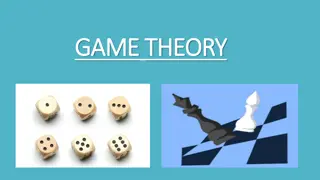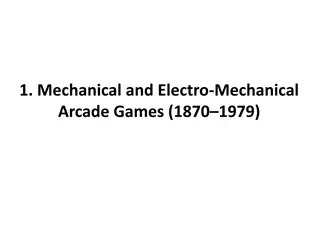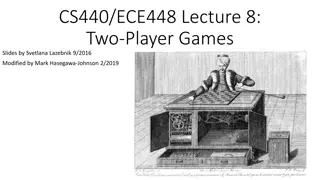Analyzing Performance Differences with 7 Defensemen vs. 6 Defensemen in Tampa Bay Lightning Games
This study examines the performance impact of rostering 7 defensemen instead of 6 in Tampa Bay Lightning games from 2013-2016. It analyzes game data, focusing on areas like injuries, time on ice distribution, team statistics, and forward stats to determine if a measurable advantage exists with a 7-defensemen structure.
Download Presentation

Please find below an Image/Link to download the presentation.
The content on the website is provided AS IS for your information and personal use only. It may not be sold, licensed, or shared on other websites without obtaining consent from the author. Download presentation by click this link. If you encounter any issues during the download, it is possible that the publisher has removed the file from their server.
E N D
Presentation Transcript
Loading up the Blue Line Eric Cantor
Introduction 2 Eric Cantor
Background What: Identify if performance differences exist with a roster structured with 7 defensemen rather than 6 How: Analyze Tampa Bay Lightning game data from 2013-2016 Why: Determine if a measurable advantage is obtained when implementing a roster structure with 7 defensemen 3 Eric Cantor
Outline 293 total games (2013-16) 92 (7D) & 201 (6D) 7D Games Distribution Season Regular (7D) Playoffs (7D) Total (7D) 13-14 82 (41) 4 (2) 86 (43) Areas of Focus: 14-15 82 (0) 26 (14) 108 (14) Relation to Injuries TOI distribution Team stats Defensemen stats Top 6 Forward stats Zone Entries Passing Project stats 15-16 82 (25) 17 (10) 99 (35) Totals 246 (66) 47 (26) 293 (92) 4 Eric Cantor
7D Games Distribution 5 Eric Cantor
Injuries (2013-14) 6 Eric Cantor
Injuries (2015-16) 7 Eric Cantor
Defense TOI Statistic 6D 7D Upper Whisker 23.60 23.73 Upper Hinge 17.42 16.05 Median 15.35 13.50 Lower Hinge 13.25 10.66 Lower Whisker 8.11 2.65 8 Eric Cantor
Top Six Forwards TOI Statistic 6D 7D Upper Whisker 21.55 20.94 Upper Hinge 14.16 14.96 Median 11.64 12.72 Lower Hinge 9.07 9.55 Lower Whisker 1.57 3.56 9 Eric Cantor
Overall Team Statistics Statistic 6D 7D Change CF60 56.04 60.07 +4.03 CA60 53.25 54.79 +(1.53) CF% 51.28% 52.31% +1.03 FF60 41.50 44.92 +3.42 FA60 40.28 40.99 +(0.71) FF% 50.88% 52.30% +1.42 SCF60 7.37 8.01 +0.64 SCA60 7.21 7.65 +(0.44) SCF% 51.01% 51.12% +0.11 xGF60 2.32 2.54 +0.22 xGA60 2.24 2.36 +(0.13) 10 Eric Cantor
Top Six Forwards Statistic 6D 7D Change CF% 50.92% 52.73% +1.81 FF% 50.42% 52.65% +2.22 xGF 0.53 0.63 +0.10 xGA 0.53 0.59 +(0.06) xGF60 2.35 2.60 +0.25 xGA60 2.35 2.40 +(0.05) Defense Statistic 6D 7D Change CF% 51.09% 52.17% +1.08 FF% 50.58% 52.04% +1.46 xGF 0.59 0.55 -0.04 xGA 0.58 0.52 -0.05 xGF60 2.31 2.51 +0.20 xGA60 2.26 2.40 +(0.14) 11 Eric Cantor
Zone Entries (2013-14) Statistic 6D 7D Change 5V5 Entry% 50.65% 50.89% +0.24 Carry-in% 49.61% 57.02% +7.41 Shots per entry 0.44 0.50 +0.06 OPP Carry-in% 47.07% 47.15% +(0.07) OPP Shots per entry 0.46 0.47 +(0.01) Passing (2015-16) Statistic 6D 7D Change A1 42.67 44.41 +1.75 SC 15.41 16.71 +1.30 12 Eric Cantor
Conclusion The potential competitive advantage of the 7D roster structure should hold much intrigue and appeal for hockey management of all levels Many potential applications and complements exist for the 7D strategy Current trend of more mobile defensemen Injury situations Much more 13 Eric Cantor
Future Exploration Ideas for future exploration include: The factor of fatigue Additional injury analysis Individual player analysis Further zone entry and exit analysis Other forms of tracking data Informative models Predictive models 14 Eric Cantor
Acknowledgements Ryan Stimson, Matthew Hoffman, and RIT Doug Ensley Michael Peterson Michael Schuckers Data Sources: Corsica.Hockey Corey Sznajder s All Three Zone Project Ryan Stimson s Passing Project NHL Injury Dataviz 15 Eric Cantor

















































